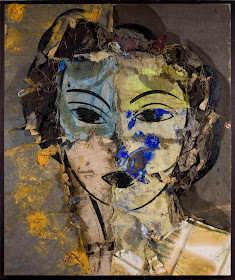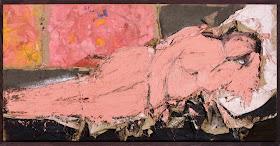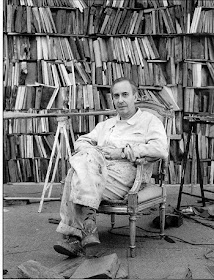A
MANOLO VALDES AT PERA MUSEUM ISTANBUL –
TURKEY PART II
May 8, 2013 – July 21, 2013
A
CONVERSATION WITH MANOLO VALDES & VIOLANT PORCEL
Violant Porcel: When did you first become interested in sculpture?
Manolo Valdés: I was already doing sculpture with the Equipo Crónica, but of a
different kind. I choose a painting—maybe from the 17th century, maybe from today—and I
interpret it first from the perspective of the painting’s specificity and then
from the perspective of sculpture. In this way, when you transform a
two-dimensional image into a three-dimensional one, it’s as if you were bringing
another observation to it;
of course, this gives it a new identity. I feel increasingly driven to carry
out this process.
VP: At first, your pictorial references in sculpture were much more obvious;
for example, artists such as Léger or Morandi. But then, as time has gone by,
you have moved towards references taken more from sculpture, maybe from
pioneering modern sculptors such as Brancusi or Giacometti. How did this change
come about?
MV: I have always used many different references, from African masks to
primitively hewn stones, or from Roman garments to Julio González’s welded
sculptures, for example. One of my greatest fears is that the things that
inspire artists like me will disappear. And, of course, the solution to this
unknown lies in the power of memory.
VP: You often rework the same theme using different materials. This
public-sculpture exhibition features the piece Lillie, a
woman wearing a hat who has also been represented in a number of your previous
paintings. The same is true of the piece Odalisque. What meandering paths
does your work process follow in this respect?
MV: All the sculptures I have made have their equivalent in paintings.
Sometimes sculpture leads me to painting, and sometimes it’s the other way
around. It is a mystery how an image finds its way into your head, but once
it’s inside, I want to fashion it in three dimensions. I suppose it’s an
impulse; call it a visceral conviction or instinct. I
might take an image by Matisse or Velázquez, for example, but the reference
that motivates me is not the painting itself but rather the way the artist
creates the work on the canvas. Or if, say, I take a work by Lipchitz as a
starting point, I do not focus on the artist’s creative approach and outcome
but on the way Lipchitz actually works the clay. Or in the case of Brancusi,
what interests me fundamentally is his way of thinking, of projecting, the
oval. And so it is with whoever it might be.
VP: Las Meninas has been an obsession of yours since you
started out with the Equipo Crónica.
MV: Yes, I am fascinated by this painting, and
I always choose the same figures from it: Reina Mariana and the Infanta Maria
Teresa. And even though I tried to keep them out of my work for periods of
time, they always reappeared in different forms. It’s an image I can keep
linking to different motifs, a subconscious motivation that can look like a
bell or other similar imagery. Today, however, I no longer try to restrict
myself in this regard; Las Meninas is an image that
continues to interest me and which is, for me, an extremely powerful one.
VP: Your work reveals a deep search into
material, in a very physical sense, shall we say. So cracks or fissures become
essential elements of your sculptures, giving them life, suggesting a
pre-existing drama or an incision in time. And if on one the hand they seem to
be the result of a process that is effectively intuitive, on the other they
acquire a sense of transcendence that can be compared to what the cuts or holes
of, say, Lucio Fontana represented. How do you work materials to achieve such
results?
MV: The sensuality of these materials interests
me a great deal, naturally. What attracts me most are waste materials, battered
and discarded, precisely because they are tortured by being broken, because
they are the result of accidents. So what I do is arrange the diverse material
I collect on the floor, then I look at it and I feel it, but one kind will
motivate me while another will not. My heart dictates what I choose. I am not a
carver, since I don’t take a uniform block and extract a sculpture from it,
waiting for it to appear to me. Rather I consider myself more a modeller of
what I use, and I work wood or metal as if they were clay.
VP: Many of the sculptures in this exhibition
are large, faceless heads wearing extravagant headdresses, an iconography that
has been a major feature of your monumental sculpture in recent years.
MV: Yes, what mainly interests me is
introducing very different registers into a single piece. So the lower part,
which is precisely the conventional face of the image, becomes more static,
whilst the upper part, the headdresses on each head, turns into the opposite,
an image of movement.
And I must admit that I adore the pronounced tension that is established
between the two parts; it’s as if they were two entirely different sculptures.
And the challenge is having them function as a harmonious whole, as well as
allowing their initially different formulation to be seen not as something
separate but rather as something enriching. Most of these pieces are made from
bronze, although the Colossuses are different since I used wrought iron for
them. Moreover, these figures came about as a result of a major exhibition on
minimalism that was held in the Guggenheim in New York, which inspired me once
again to achieve that tension between opposites that is a feature of my work,
and that in this instance I obtained by combining thick metal sheets with
simple shapes.
VP: How did this emphasis on space, on size,
appear in your work?
MV: Over time, I designed my sculptures on an
ever-larger scale, until the time came when they had to be outside; that is,
they had to move out of the studio and onto the street. In any case, I am
generally not a great fan of outsized sculptures on principle; in fact most of
the time I prefer sculptures of modest dimensions, ones that you can get close
to without feeling intimidated by them. I live in Manhattan, near Central Park,
where there is a sculpture of Alice in Wonderland, another of a dog, and you
always see children playing on them. And, you know, I envy that friendly bond
between the sculptures, magnificent in their “thereness”, and the person who
looks at them or who simply accepts them as part of the surroundings. Later,
after I had these experiences and ideas, I was commissioned to create public
pieces, and I realised that my own work could be on a larger scale, too.
VP: There’s a renewed interest in art on the
street and, consequently, a debate about how it should relate to its setting.
What is your opinion on this?
MV: Seeing sculptures on the streets is
interesting; they take on another perspective. People contemplate them in a far
less formal way than they do in museums, experiencing feelings of admiration or
rejection towards them in a very direct way. This suggests that there are
sculptures whose style and content are different and even conflicting. So it is
really exciting when, in an urban environment, there are groups of sculptures
that are heterogeneous to the point of almost causing conceptual confrontation
between their elements. And I am horrified that people are supposed to blindly
accept a single discourse. Hasn’t the 20th century’s fundamental contribution to
art been a stunning variety of ideas? We all defend our own creation, its
specificity. This is undeniable, and it ties in with the fact that the artistic
heritage of towns and cities comes from accumulating works from throughout
history, which in itself is an extraordinary lesson in freedom.
VP: You have often used references to Spanish
art. Do you think that explicitly national art exists these days, or do you see
it as something outdated and overtaken by globalisation and the power of the
international market?
MV: Artistic transgressions and influences have
existed throughout history. For example, Velázquez’s time in Italy had a
decisive influence on his work. Today, the exchange is more fluid. There are
magazines and aeroplanes, and people even travel to other countries just to see
an exhibition. If we take New York as an example, there are currently two exhibitions
that illustrate this process: the Guggenheim has a major exhibition on Spanish
art, ranging from El Greco to Picasso, and the Whitney Museum of American Art
has an exhibition on Picasso’s influence on American art, which demonstrates
that influences have been around for a long time.
VP: You have lived in New York for so long. Do
you think that it is a good idea, even necessary, for artists to move around
today?
MV: I don’t consider it necessary, but in my
own case it is certainly true that I emigrated to New York in search of a
better life. Not all famous artists live in this city, although a large number
of important events do take place here. When an artist has an exhibition or
works in New York, they feel more driven, perhaps more exacting. I believe that
it is a positive move to come here in search of information. Throughout
history, they have always been cultural hubs… If you stay in one place, your risk
becoming shut in. However, this is less common these days.
You may reach to see Manolo Valdes's Exhibition news part I at
Pera Museum Istanbul and Marlborough Gallery New York Press Releass with more
paintings to click below links.
http://mymagicalattic.blogspot.com.tr/2013/11/manolo-valdes-at-marlborough-gallery.html
DOROTHY ON GRAY BACKROUND 2010 ( DETAIL )
A
DOROTHY ON GRAY BACKROUND 2010 ( DETAIL )
LILLIE X – 2005
A
HEAD II, 2011
Alabaster and Iron
Dimensions: 61 x 76 x 61 cm
© Artist Manolo Valdes 2013
NUDE IN OCHRE II – 2010
NUDE IN OCHRE II – 2010 ( DETAIL )
LEAF IV 1999
A
LADY WITH BLUE HAT 2009
LADY WITH BLUE HAT 2009 ( DETAIL )
A
A
LADY WITH BLUE HAT 2009 ( DETAIL )
PROFILE IV - 2006
A
PROFILE III, 2006
Etching and Silkscreen
Edition of 50,
Dimensions: 167.6 x 129.5 cm
© Artist Manolo Valdes 2013
NUDE IN PINK 2010
PERA MUSEUM ISTANBUL
PERA MUSEUM ISTANBUL
Inaugurated on 8 June 2005, Pera Museum is a private
museum founded by the Suna and İnan Kıraç Foundation. The aim of offering an
outstanding range of diverse high quality culture and art services is as
important today as when the Museum first opened its doors to the public.
Couched in the historic quarter of Tepebaşı, the
impressive building was originally conceived as the Bristol Hotel, designed by
architect Achille Manoussos. Restorer and architect Sinan Genim was given the
daunting renovation operation in 2003; the triumph of transforming the interior
into a modern and fully equipped museum is only matched by the architect’s
mastery in simultaneously preserving the exterior façade, safeguarding an
integral part of Istanbul’s architectural flavour.
Through Suna and İnan Kıraç Foundation's three
permanent collections, “Orientalist Paintings”, “Anatolian Weights and
Measures”, and “Kütahya Tiles and Ceramics”, Pera Museum seeks not only to
diffuse the aesthetic beauty of these collections but also to create dialogue
with the public concerning the values and identities that they
encompass. Utilizing a full scope of innovative methods, including
exhibitions, publications, audio-visual events, educational activities, and
academic works, the objective of transmitting the beauty and importance of
these works to future generations is realised. Having organized joint projects
with leading international museums, collections, and foundations including Tate
Britain, Victoria and Albert Museum, St. Petersburg Russian State Museum, JP
Morgan Chase Collection, New York School of Visual Arts, and the Maeght
Foundation, Pera Museum has introduced Turkish audiences to countless
internationally acclaimed artists. Some of the most illustrious amongst these
include Jean Dubuffet, Henri Cartier-Bresson, Rembrandt, Niko Pirosmani, Josef
Koudelka, Joan Miró, Akira Kurosawa, Marc Chagall, Pablo Picasso, Fernando
Botero, Frida Kahlo, Diego Rivera, and Goya.
Since its inauguration, Pera Museum collaborates
annually with national and international institutions of art and education to
hold exhibitions that support young artists. All of the Museum’s exhibitions
are accompanied by books, catalogues, audio-visual events in addition to
education programs. Parallel to its seasonal programs and events, Pera Film offers
visitors and film buffs a wide range of screenings that extend from classics
and independent movies to animated films and documentaries. Pera Film also
hosts special shows that directly correlate with the temporary exhibitions’
themes.
Pera Museum has evolved to become a leading and
distinguished cultural center in one of the liveliest quarters of İstanbul.
http://www.peramuseum.org/Content/about-pera-museum/58
PERA MUSEUM ISTANBUL
PORTRAIT WITH YELLOW AND BLUE FACE, 1999
Oil on Burlap
Dimensions: 242.4 x 171.8 cm
© Artist Manolo Valdes 2013
PERA MUSEUM WELCOMES GREAT
SPANISH MASTER MANOLO VALDES
Pera Museum salutes the spring
of 2013 with an extensive exhibition comprised of the paintings and sculptures
of Manolo Valdés, one of Spain’s most important contemporary artists.
As one of the founding members
of Equipo Crónica, a pioneering movement in contemporary art established in
1964, Valdés started working solo and set his own distinctive style from 1981
onwards.
Taking inspiration from
ancient civilizations, old masters of the Spanish Golden Age such as Velázquez,
Zurbarán, and Goya, and more recent artists such as Matisse, Picasso, Léger and
Brancusi, as well as focusing on current themes, Valdés created fascinating
works of art in the ensuing years.
Having captured the attention
of the art world through paintings he often executed with burlap and layered
paint, as well as sculptures of metal, wood, and alabaster, Valdés left his
imprint on contemporary art with his unique approach, rendition, and works.
With his fresh take on the works and subjects from which
he—self-admittedly—derives his inspiration, Valdés transforms a two-dimensional
image into a three-dimensional one and lends the work a new identity.
Comprised of 59 works, 46
paintings and 13 sculptures, focusing predominantly on the subject of the
female, this exhibition will not only take art-lovers on a pleasant journey
across Valdés’s rich and colourful world of imagination that extends from
ancient civilizations to great masters of the past and present, but it will
also draw considerable interest from art circles in Turkey and abroad.
Pera Museum brought this
exhibition to life over a period of two years in collaboration with Marlborough
Gallery New York, one of the leading galleries in the world. We would thus like
to take this opportunity to extend our heartfelt appreciation to the esteemed
artist Manolo Valdés, the Marlborough Gallery New York management and staff,
the Suna and İnan Kıraç Foundation Pera Museum team, as well as all other
individuals and institutions that have contributed towards this project.
Suna, İnan, & İpek Kıraç
A
B
CLOVER 2009
CLOVER 2009 ( DETAIL )
A
CLOVER 2009 ( DETAIL )
ZURBARAN AS
PRETEXT 1988
A
A
BUTTERFLIES V –
2011
PORTRAIT IN
WHITE & RED 1999
PORTRAIT IN WHITE & RED 1999 ( DETAIL )
PORTRAIT IN WHITE & RED 1999 ( DETAIL )
A
LADY ON HORSE
B II – 2012
PORTRAIT IN
BLUE & ORANGE 2010
TULIPS ON
WHITE BACKROUND 2007 ( DETAIL )
TULIPS ON WHITE BACKROUND 2007
TULIPS ON WHITE BACKROUND 2007
A
HELENE V, 2005
Etching and Collage
Edition of 50
Dimensions: 165 x 96.5 cm
© Artist Manolo Valdes 2013
MANOLO VALDÉS
1942 Born in
Valencia, Spain, on March 8th
1957 Entered
the Real Academia de Bellas Artes
de San Carlos de Valencia, Spain; left in 1958 to devote his life to painting
1964-81 Formed the group “Equipo Crónica” with
Joan A. Toledo and Rafael
Solbes; Toledo left the group after a year but Valdés and Solbes
continued their association with “Equipo Crónica” until the death of Solbes in
1981. As a member of “Equipo Crónica,” Manolo Valdés participated in over sixty
solo exhibitions and numerous group exhibitions.
The artist lives and works in New York, USA and Madrid, Spain.
AWARDS AND HONORS
1965 Biella
Prize, Comune di Biella, Milan, Italy
1979 Silver
medal, 2nd International
Biennial of Prints, Tokyo, Japan
Prize, Bridgestone Museum of Art,
Lisbon, Portugal
1985 National
Medal of Fine Arts, Government of Spain, Madrid, Spain
1986 Medal of
the Biennial, International Festival of the Plastic Arts, Baghdad,
Iraq
1993 Order of
Andrés Bello Award, Honour Class, Caracas, Venezuela
1997 32nd Prize of the National Council, La
Fondation Prince Pierre de Monaco, Monte Carlo, Monaco
1998 Gold Medal of Merit in the Fine Arts,
Minister of Culture of Spain, Madrid, Spain
1999 Representative
for Spain, International Art Exhibition, Venice Biennial, Venice, Italy
2000 The
Spanish Association of Art Critics Award for Print, Madrid, Spain
The Spanish Association of Art Critics
Award for ARCO, Madrid, Spain
2002 The
Spanish Association of Art Critics Award for Print, Madrid, Spain
2004 Valenciano
Award of the 21st Century,
Las Provincias, Valencia, Spain
2005 Order of Cultural Merit, Ordonnance
Souveraine, Monte Carlo, Monaco
2006 Archival
Award Spain 2005, Madrid, Spain
Doctor Honoris Causa, University
Miguel Hernández, Elche, Spain
2007 National Order of Merit, President of the
French Republic, Paris, France
2010 International Medal of Community Arts
of Madrid, Madrid, Spain
















































































